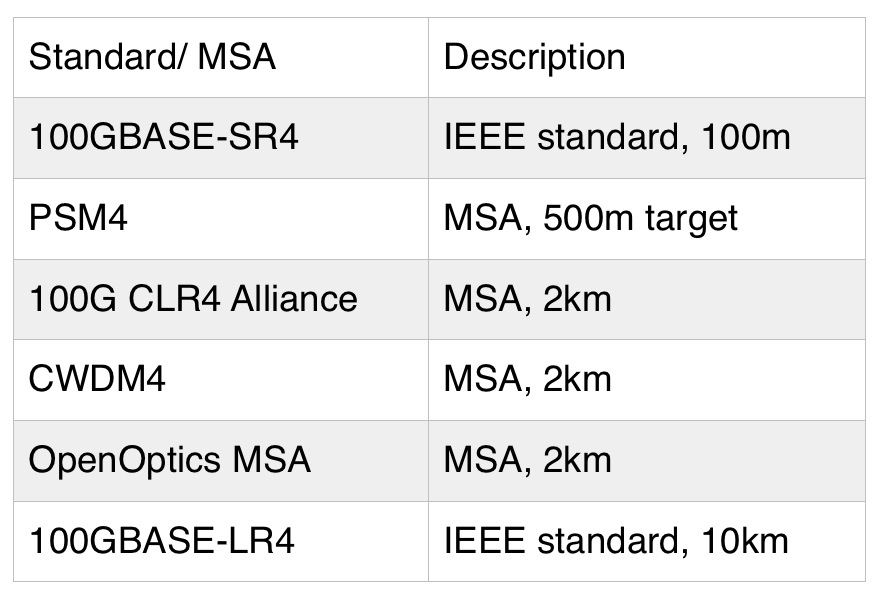Another day, another multi-source agreement.
The CLR4 Alliance is the latest 100 Gig multi-source agreement (MSA) to address up-to-2km links in the data centre. The 100 Gig CLR4 Alliance is backed by around 20 companies including data centre operators, equipment vendors, optical module and component players and chip makers.
 The table provides a summary of the latest MSAs and how they relate to the IEEE 100 Gigabit client interface standards. Source: Gazettabyte.
The table provides a summary of the latest MSAs and how they relate to the IEEE 100 Gigabit client interface standards. Source: Gazettabyte.
The announcement follows in the footsteps of the CWDM4 MSA, announced at the start of the week. The CWDM4 is another 100 Gig single-mode fibre MSA backed by optical module makers, Avago Technologies, Finisar, JDSU and Oclaro.
The two MSAs are the latest of several announced interfaces - three in the last three weeks - to tackle mid-reach distances from 100m-plus to 2km. The MSAs reflect an industry need to fill the void in the IEEE standards: the -SR4 multimode standard, with its 100m reach, and the 10km -LR4 that is seen as over-specified for data centre requirements.
Below is a discussion of the recent data centre MSAs
The PSM4 MSA
The PSM4 MSA is a four-channel parallel single mode interface that uses eight- or 12-fibre cabling based on the MTP/MPO optical connectors. The PSM4 uses simpler optics than the 10km IEEE 100GBASE-LR4 and the shorter-reach 2km offshoot, the CWDM4 MSA, and thus promises lower cost. But this is at the expense of using eight fibres and more expensive connectors compared to the single-mode CWDM4.
The PSM4 is expected to have a reach of at least 500m; above that the cost of the fibre becomes the dominant factor. "Note that a 500m PMD [physical medium dependent layer] at 100 Gig was an objective of the IEEE 802.3bm group but it did not happen, so the industry is defining products that fill the gap," says Dale Murray, principal analyst at LightCounting Market Research.
The PSM4 MSA was first detailed in January and includes such members as Avago Technologies, Brocade, JDSU, Luxtera, Oclaro and Panduit.
The 100 Gig CLR4 Alliance
The 100 Gig CLR4 MSA is backed by companies including ebay; equipment vendors Arista Networks, Brocade, Dell, Fujitsu, HP, and Oracle; silicon photonics players Aurrion, Intel, Skorpios Technologies (Oracle is also a proponent of silicon photonics); optical module and component players ColorChip, Kaiam, Oclaro, Oplink, NeoPhotonics; and chip vendors, Netronome and Semtech.
The 100 Gig standard is based on a QSFP form factor module and uses two single mode fibres - 1 send and 1 receive - for duplex communications. The MSA has a 2km reach and uses coarse wavelength-division multiplexing (CWDM). The 8.5mm x18mm x 72mm QSFP has a maximum power consumption of 3.5W and enables a port density of 36 modules on a face plate of a 1 rack unit card, or 3.6 Terabits overall.
At the recent OFC show, Skorpios Technologies demonstrated a QSFP28-CLR4. The silicon photonics player said its module was based on a single-chip that integrates the lasers, modulators, detectors and optical multiplexer and de-multiplexer, to deliver significant size, cost and power benefits. It also said the transceiver achieved a reach of 10km, putting its CLR4 on a par with the IEEE -LR4
At OFC ColorChip announced its iLR4 which is a QSFP28 with a 2km although, like with Skorpios, this was before the 100G CLR4 Alliance launch.
The CWDM4 MSA
The CWDM4 MSA also uses 4-channel CWDM optics and two-fibre cabling. The CWDM4 is being promoted as a complement to the PSM4. "It is MSA-based and has a 2km target," says Murray. "This is an LR4 with relaxed specs; it has no thermal electric cooler but uses the same wavelengths."
"From the link solution point of view, the PSM4 may be more cost effective than the CWDM4 up to 200m-300m," says I-Hsing Tan, segment marketing manager for Ethernet and storage optical transceivers at Avago. "But CWDM4 is for sure the winner beyond 200m and can be more cost effective than the 100GBASE-LR4 solution up to 2km."
Companies backing the CWDM4 MSA include Avago Technologies, Finisar, JDSU and Oclaro.
The OpenOptics MSA
The OpenOptics MSA was launched at OFC by Mellanox Technologies and Ranovus. The MSA uses 1550nm optics and DWDM. The first implementation will be a 100G QSFP28 module and the distance it will address is up to 2km. The MSA will also support future 400 Gig and greater interface speeds.
The degree of acceptance of the OpenOptics MSA is still to be determined compared to the more broadly backed CWDM4.
Other developments
The CLR4 Alliance may not be the final word regarding MSA announcements for the data centre.
Work is ongoing to use advanced modulation for data centre links, such as PAM-8 and carrier multi-tone.
Both Ciena's Joe Berthold and Ovum's Daryl Inniss address the importance of client-side interfaces and whether the rush to announce new MSAs is beneficial overall.
The story was first published on April 1st and has been updated to include the CLR4 Alliance MSA.